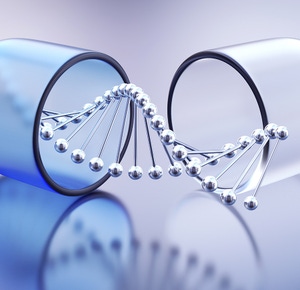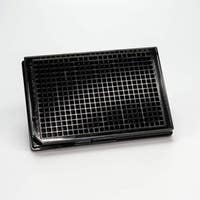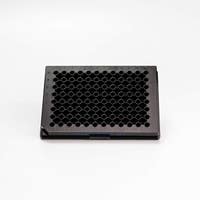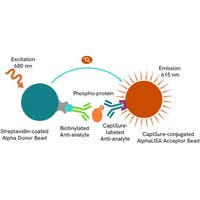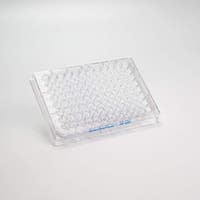

AlphaLISA SureFire Ultra High Performance Human Phospho-STAT6 (Tyr641) Detection Kit, 50,000 Assay Points
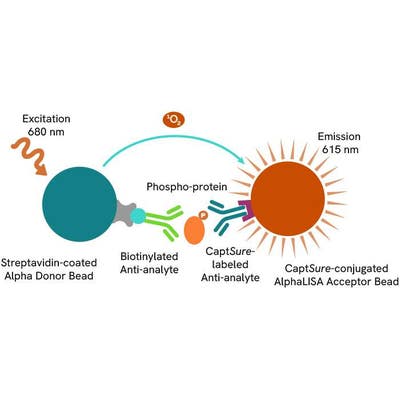

AlphaLISA SureFire Ultra High Performance Human Phospho-STAT6 (Tyr641) Detection Kit, 50,000 Assay Points
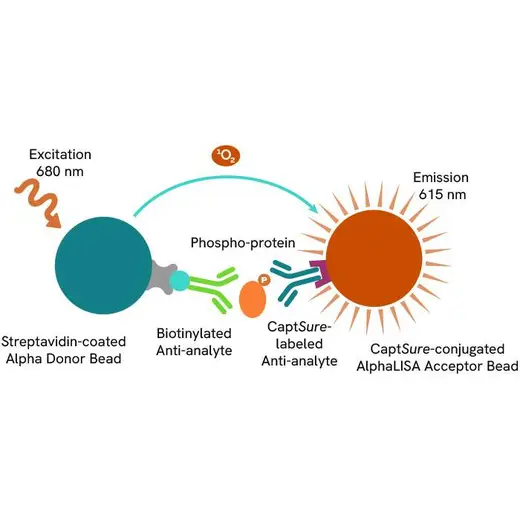


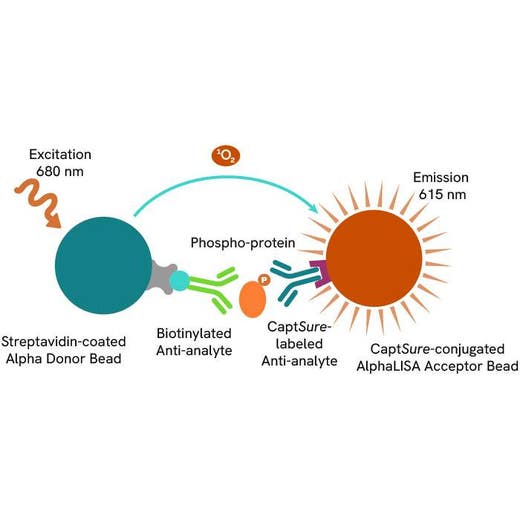


The AlphaLISA™ SureFire® Ultra™ High Performance Human Phospho-STAT6 (Tyr641) assay is a sandwich immunoassay for quantitative detection of phospho-STAT6 (Tyr641) in cellular lysates using Alpha Technology.
| Feature | Specification |
|---|---|
| Application | Cell Signaling |
| Protocol Time | 2h at RT |
The AlphaLISA™ SureFire® Ultra™ High Performance Human Phospho-STAT6 (Tyr641) assay is a sandwich immunoassay for quantitative detection of phospho-STAT6 (Tyr641) in cellular lysates using Alpha Technology.



AlphaLISA SureFire Ultra High Performance Human Phospho-STAT6 (Tyr641) Detection Kit, 50,000 Assay Points



AlphaLISA SureFire Ultra High Performance Human Phospho-STAT6 (Tyr641) Detection Kit, 50,000 Assay Points



Product information
Overview
Signal Transducer and Activator of Transcription 6 (STAT6) is a critical transcription factor in the JAK/STAT signaling pathway, primarily activated by interleukin-4 (IL-4) and interleukin-13 (IL-13). Upon activation, STAT6 dimerizes and translocates to the nucleus, where it regulates the expression of genes involved in anti-apoptotic and T helper 2 (Th2) immune responses. Dysregulation of STAT6 drives inflammation and hypersensitivity in allergic diseases like asthma, supports tumor survival and proliferation in cancers such as lymphomas, and plays a minor role in antiviral immunity through the STING pathway.
The AlphaLISA SureFire Ultra High Performance Human Phospho-STAT6 (Tyr641) Detection Kit is a sandwich immunoassay for the quantitative detection of phospho-STAT6 in cellular lysates, using Alpha Technology.
Formats:
- The HV (high volume) kit contains reagents to run 100 wells in 96-well format, using a 60 μL reaction volume.
- The 500-point kit contains enough reagents to run 500 wells in 384-well format, using a 20 μL reaction volume.
- The 10,000-point kit contains enough reagents to run 10,000 wells in 384-well format, using a 20 μL reaction volume.
- The 50,000-point kit contains enough reagents to run 50,000 wells in 384-well format, using a 20 μL reaction volume.
AlphaLISA SureFire Ultra kits are compatible with:
- Cell and tissue lysates
- Antibody modulators
- Biotherapeutic antibodies
AlphaLISA SureFire Ultra kits can be used for:
- Cellular kinase assays
- Receptor activation studies
- High-throughput screening for preclinical studies
Specifications
| Application |
Cell Signaling
|
|---|---|
| Automation Compatible |
Yes
|
| Brand |
AlphaLISA SureFire Ultra
|
| Detection Modality |
Alpha
|
| Protocol Time |
2h at RT
|
| Shipping Conditions |
Shipped in Blue Ice
|
| Target |
STAT6
|
| Target Class |
Phosphoproteins
|
| Target Species |
Human
|
| Technology |
Alpha
|
| Therapeutic Area |
Oncology
|
| Unit Size |
50,000 assay points
|
Video gallery

AlphaLISA SureFire Ultra High Performance Human Phospho-STAT6 (Tyr641) Detection Kit, 50,000 Assay Points

AlphaLISA SureFire Ultra High Performance Human Phospho-STAT6 (Tyr641) Detection Kit, 50,000 Assay Points

How it works
Phospho-AlphaLISA SureFire Ultra assay principle
The Phospho-AlphaLISA SureFire Ultra assay measures a protein target when phosphorylated at a specific residue.
The assay uses two antibodies which recognize the phospho epitope and a distal epitope on the targeted protein. AlphaLISA assays require two bead types: Acceptor and Donor beads. Acceptor beads are coated with a proprietary CaptSure™ agent to specifically immobilize the assay specific antibody, labeled with a CaptSure tag. Donor beads are coated with streptavidin to capture one of the detection antibodies, which is biotinylated. In the presence of phosphorylated protein, the two antibodies bring the Donor and Acceptor beads in close proximity whereby the singlet oxygen transfers energy to excite the Acceptor bead, allowing the generation of a luminescent Alpha signal. The amount of light emission is directly proportional to the quantity of phosphoprotein present in the sample.

Phospho-AlphaLISA SureFire Ultra two-plate assay protocol
The two-plate protocol involves culturing and treating the cells in a 96-well plate before lysis, then transferring lysates into a 384-well OptiPlate™ plate before the addition of Phospho-AlphaLISA SureFire Ultra detection reagents. This protocol permits the cells' viability and confluence to be monitored. In addition, lysates from a single well can be used to measure multiple targets.
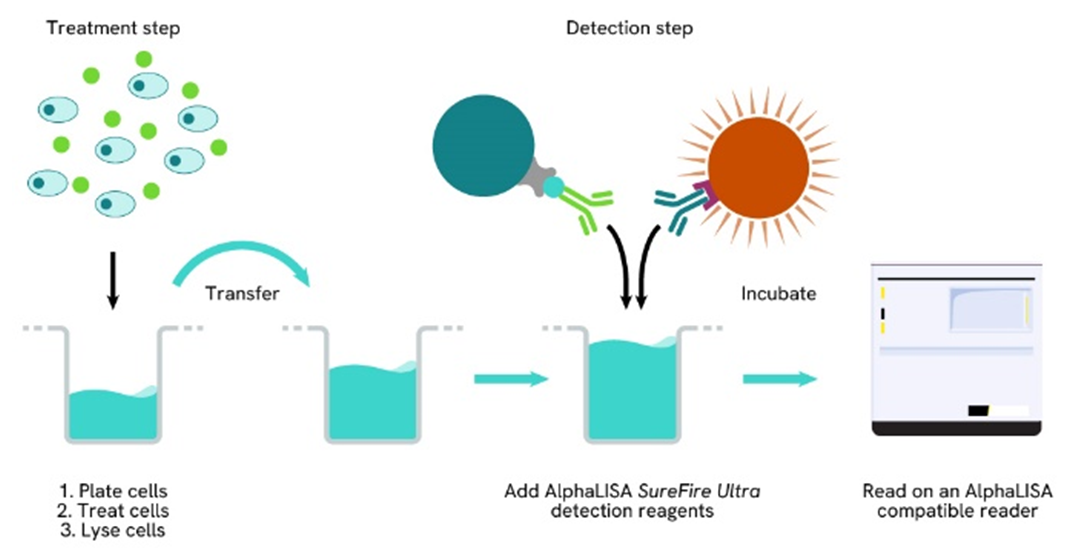
Phospho-AlphaLISA SureFire Ultra one-plate assay protocol
Detection of Phosphorylated target protein with AlphaLISA SureFire Ultra reagents can be performed in a single plate used for culturing, treatment, and lysis. No washing steps are required. This HTS designed protocol allows for miniaturization while maintaining AlphaLISA SureFire Ultra quality.
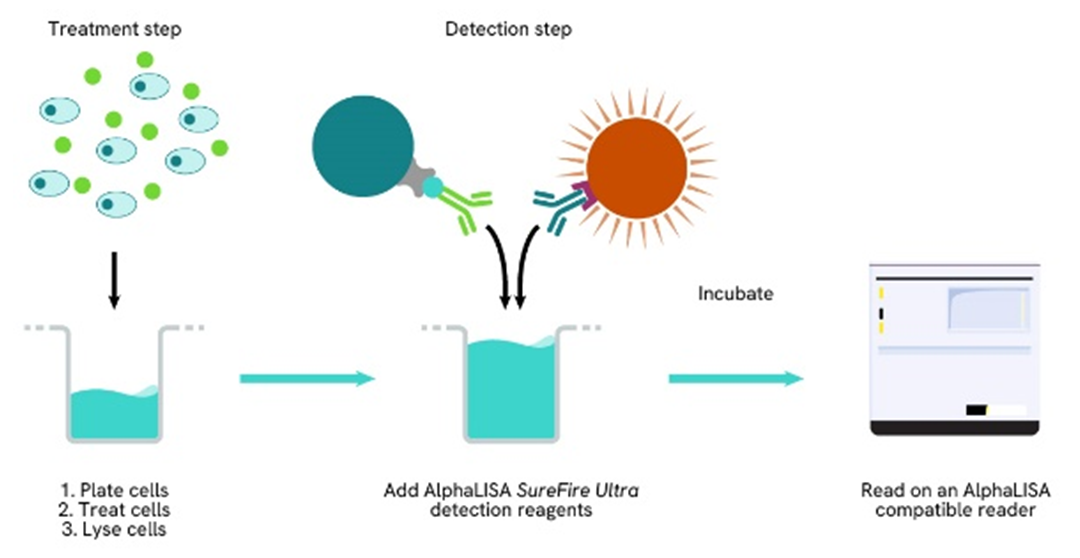
Assay validation
Activation of STAT6 Phospho (Tyr641) in primary macrophages
PBMCs were isolated from healthy donors and cultured for 6 days in complete DMEM containing 20 ng/mL M-CSF to differentiate them into macrophages. Macrophages were seeded in a 96-well plate (30,000 cells/well) in complete DMEM, and incubated overnight at 37°C, 5% CO2. The cells were then treated with increasing concentrations of IL-4 for 20 minutes.
After treatment, the cells were lysed with 100 µL of Lysis Buffer for 10 minutes at RT with shaking (350 rpm). STAT6 Phospho (Tyr641) and Total levels were evaluated using AlphaLISA SureFire Ultra Phospho (Tyr641) (HP) and Total STAT6 assays. For the detection step, 10 µL of cell lysate (approximately 3,000 cells/datapoint) were transferred into a 384-well white OptiPlate, followed by 5 µL of Acceptor mix and incubated for 1 hour at RT. Finally, 5 µL of Donor mix was then added to each well and incubated for 1 hour at RT in the dark. The plate was read on an Envision using standard AlphaLISA settings.
As expected, IL-4 triggered a dose-dependent increase in the levels of STAT6 Phospho (Tyr641) while Total STAT6 levels remained unchanged.
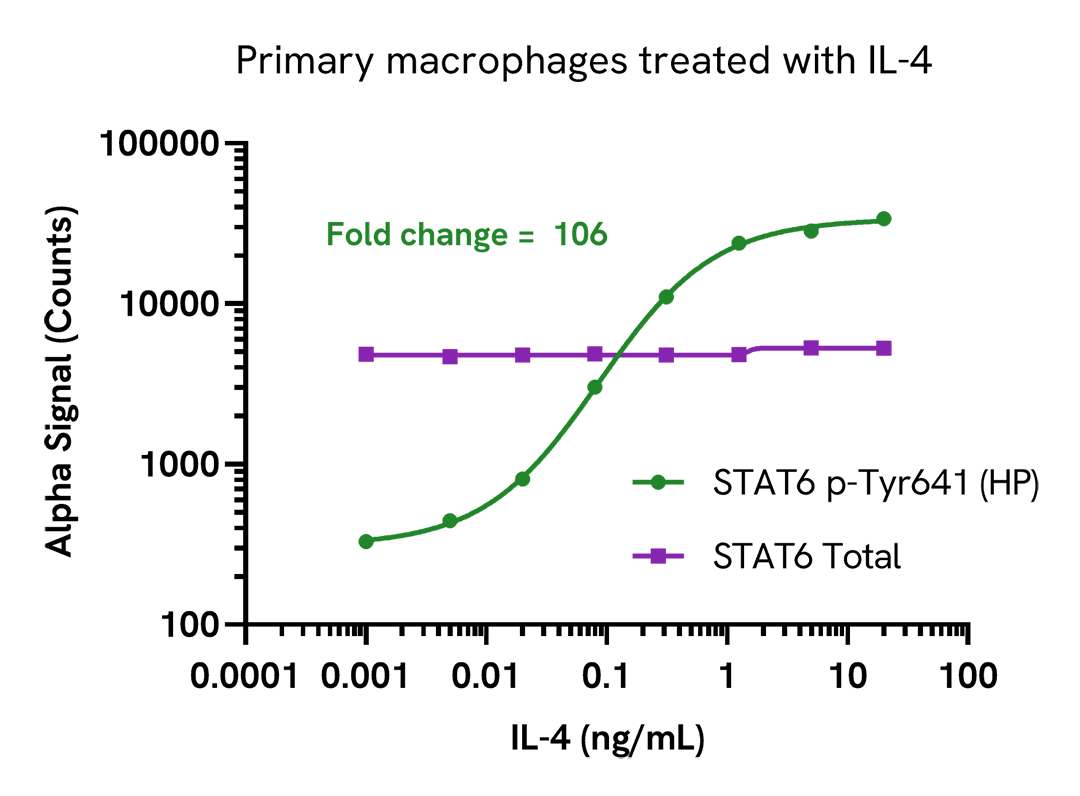
Activation of STAT6 Phospho (Tyr641) in THP-1 cells
THP-1 cells were seeded in a 96-well plate (400,000 cells/well) in HBSS + 0.1 % BSA and treated with increasing concentrations of IL-4 for 20 minutes.
After treatment, the cells were lysed with the addition of 50 µL of 5X Lysis Buffer for 10 minutes at RT with shaking (350 rpm). STAT6 Phospho (Tyr641) and Total levels were evaluated using AlphaLISA SureFire Ultra Phospho (Tyr641) (HP) and Total STAT6 assays. For the detection step, 10 µL of cell lysate (approximately 16,000 cells/datapoint) were transferred into a 384-well white OptiPlate, followed by 5 µL of Acceptor mix and incubated for 1 hour at RT. Finally, 5 µL of Donor mix was then added to each well and incubated for 1 hour at RT in the dark. The plate was read on an Envision using standard AlphaLISA settings.
As expected, IL-4 triggered a dose-dependent increase in the levels of STAT6 Phospho Tyr641 (HP) while Total STAT6 levels remained unchanged.

Activation of STAT6 Phospho (Tyr641) in A431 cells
A431 cells were seeded in a 96-well plate (60,000 cells/well) in complete medium and incubated overnight at 37°C, 5% CO2. The cells were then treated for 20 minutes with increasing concentrations of IL-4.
After treatment, the cells were lysed with 150 µL of Lysis Buffer for 10 minutes at RT with shaking (350 rpm). STAT6 Phospho (Tyr641) and Total levels were evaluated using AlphaLISA SureFire Ultra Phospho (Tyr641) (HP) and Total STAT6 assays. For the detection step, 10 µL of cell lysate (approximately 4,000 cells/datapoint) were transferred into a 384-well white OptiPlate, followed by 5 µL of Acceptor mix and incubated for 1 hour at RT. Finally, 5 µL of Donor mix was then added to each well and incubated for 1 hour at RT in the dark. The plate was read on an Envision using standard AlphaLISA settings.
As expected, IL-4 triggered a dose-dependent increase in the levels of Phospho STAT6 Tyr641 (HP) while Total STAT6 levels remained unchanged.

Resources
Are you looking for resources, click on the resource type to explore further.
The definitive guide for setting up a successful AlphaLISA SureFire Ultra assay
Several biological processes are regulated by...
Discover Alpha SureFire® Ultra™ assays, the no-wash cellular kinase assays leveraging Revvity's exclusive bead-based technology...
This document includes detailed tables listing HTRF™, AlphaLISA™ SureFire® Ultra™, and Alpha SureFire® Ultra™ Multiplex assays...
SDS, COAs, Manuals and more
Are you looking for technical documents related to the product? We have categorized them in dedicated sections below. Explore now.
- Lot NumberU21048Lot DateApril 1, 2025
- Lot Number-Lot Date-
- Resource TypeManual言語English国-


How can we help you?
We are here to answer your questions.





